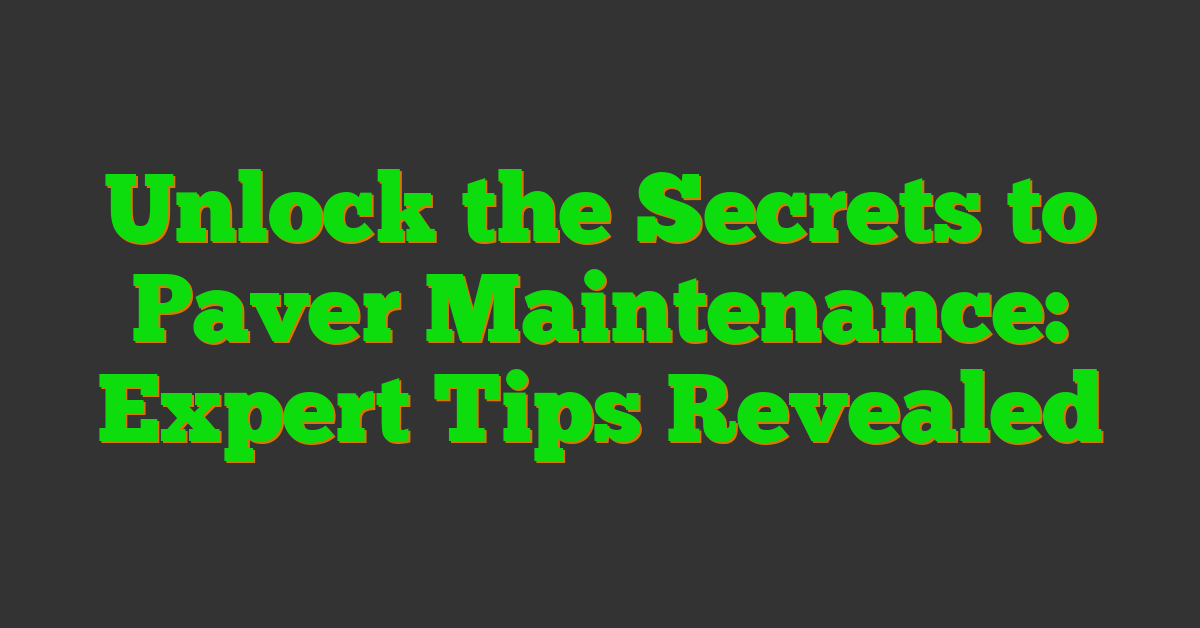Have you ever noticed sunken pavers in your outdoor space and wondered what causes this common issue? Well, we’re here to shed some light on the reasons behind those unsightly dips in your beautiful walkway or patio. Sunken pavers can be a nuisance, but understanding the root causes can help you prevent them in the future.

From improper installation to poor drainage, there are several factors that can lead to sunken pavers. By identifying these culprits early on, we can take proactive steps to ensure our outdoor surfaces remain level and inviting. So, let’s explore the common causes of sunken pavers and learn how we can keep our outdoor spaces looking their best.
Understanding Sunken Pavers
The Basics of Paver Installation
When it comes to the common issue of sunken pavers, one key aspect to consider is the installation process. Proper installation plays a crucial role in preventing pavers from sinking over time. Ensuring a solid and stable foundation is essential in maintaining the integrity of a paved surface. By compacting the base material adequately and following the recommended installation techniques, we can help minimize the risk of pavers settling unevenly or sinking in the future.
Importance of Subsurface Preparation
In the realm of outdoor design, the importance of subsurface preparation cannot be overstated. Adequate subsurface preparation is fundamental in creating a durable and long-lasting outdoor space. By properly excavating the area, compacting the soil, and adding a suitable base material, we create a stable foundation for the pavers to rest upon. This meticulous preparation work not only helps prevent issues like sunken pavers but also enhances the overall stability and longevity of the paved surface. Investing time and effort into subsurface preparation can significantly impact the performance and aesthetic appeal of outdoor spaces.
Common Causes of Sunken Pavers
Improper Foundation and Compaction
When we talk about sunken pavers, one of the primary culprits is often improper foundation preparation and compaction. Sometimes, shortcuts are taken during the installation process, leading to an unstable base that cannot support the weight of the pavers adequately. Without a solid foundation, the pavers are more likely to shift and settle over time, causing uneven surfaces and potential tripping hazards.
Weather-Related Factors
Weather can also play a significant role in causing pavers to sink. Changes in temperature, excessive rain, or poor drainage can weaken the base materials underneath the pavers, leading to sinking and shifting. Freeze-thaw cycles, common in many regions, can further exacerbate the problem by expanding and contracting the ground beneath the pavers, disrupting their stability.
Poor Drainage
Inadequate drainage is another common issue that can result in sunken pavers. When water is not properly diverted away from the paved area, it can saturate the base materials, causing them to lose their integrity. Over time, this waterlogged base will give way, causing the pavers to sink and creating an uneven surface. Proper drainage solutions are essential to maintain the longevity of outdoor paved areas.
Tree Roots and Organic Material
The presence of tree roots and organic material beneath the pavers can also contribute to sinking. As trees grow, their roots can push up against the pavers, disrupting the underlying base and causing them to settle unevenly. Additionally, the decomposition of organic matter beneath the surface can create voids, leading to instability and eventual sinking of the pavers.
Excessive Load and Traffic
Excessive load and traffic on the paved surface can expedite the sinking of pavers. Heavy vehicles, equipment, or frequent foot traffic can put undue stress on the pavers and the base materials, causing them to compact and settle over time. Ensuring that the paved area is designed to withstand the expected load and traffic patterns is crucial in preventing premature sinking of the pavers.
By understanding these common causes of sunken pavers, we can take proactive measures to address these issues during the design and installation process, ensuring a durable and long-lasting outdoor paved area for our clients.
Preventative Measures and Solutions
Proper Installation Techniques
When it comes to preventing sunken pavers in outdoor spaces, our focus as landscape designers is on implementing proper installation techniques. Ensuring a stable foundation is key to the longevity of the paved area. By compacting the base material adequately and using quality bedding sand, we can create a solid base for the pavers to sit on. Properly setting the pavers with uniform spacing and a slight slope for water drainage helps maintain their position over time.
Maintenance Tips to Prevent Sinking
To prevent sinking issues with pavers, regular maintenance is essential. As landscape designers, we recommend inspecting the paved area periodically to identify any signs of uneven settling. By addressing small issues promptly, we can prevent them from escalating into larger problems. Removing debris and organic material that can accumulate between the pavers helps prevent destabilization. Additionally, resetting any sunken pavers and replacing damaged ones can help maintain the structural integrity of the paved surface. Regularly sweeping and cleaning the area also aids in preventing issues related to poor drainage and organic material buildup.
By focusing on proper installation techniques and implementing diligent maintenance practices, we can effectively address and prevent sunken pavers in outdoor spaces, ensuring a durable and visually appealing paved area for our clients.
Repairing Sunken Pavers
Assessing the Damage
When addressing sunken pavers, our first step is to assess the extent of the damage. We need to identify the areas where the pavers have sunk and understand the underlying cause. By inspecting the affected areas, we can determine whether the issue is localized or widespread. This initial assessment is crucial as it helps us plan our repair strategy effectively.
Step-by-Step Guide to Fixing Sunken Pavers
Once we have assessed the damage, we can proceed with fixing the sunken pavers. Here’s our step-by-step guide to restoring the integrity of the paved surface:
- Remove the Affected Pavers: Carefully lift and remove the sunken pavers from the affected area, ensuring not to damage surrounding ones.
- Address the Underlying Cause: After removing the pavers, we investigate the reason for the sinking. It could be due to poor compaction of the base material, erosion of bedding sand, or other issues. Addressing the root cause is essential to prevent future sinking.
- Recompact the Base: Once we’ve identified the cause, we recompact the base material to stabilize the area. Proper compaction ensures a solid foundation for the pavers to sit on, reducing the risk of sinking.
- Replace and Level: After recompacting the base, we carefully replace the pavers in their original positions. Using a level, we ensure that the pavers are even and aligned correctly.
- Add Joint Sand: To secure the pavers in place, we fill the joints with polymeric sand. This specialized sand hardens when dampened, providing stability to the paved surface.
- Compact and Seal: Finally, we compact the entire paved surface to set the pavers firmly in place. Sealing the pavers with a protective sealant helps enhance their longevity and resistance to external elements.
By following these steps diligently, we can effectively repair sunken pavers and restore the beauty and functionality of outdoor paved areas.
Conclusion
Ensuring proper installation and maintenance of pavers is crucial in preventing sunken pavers in outdoor spaces. Factors such as inadequate foundation preparation, weather conditions, tree roots, and excessive load can contribute to this issue. Repairing sunken pavers involves assessing the damage, addressing the root cause, recompacting the base, replacing and leveling the pavers, adding joint sand, and compacting and sealing the surface. By following these steps diligently, outdoor paved areas can be effectively restored, maintaining both aesthetics and functionality. Remember, proactive care and timely repairs are key to enjoying a long-lasting and visually appealing outdoor space.










